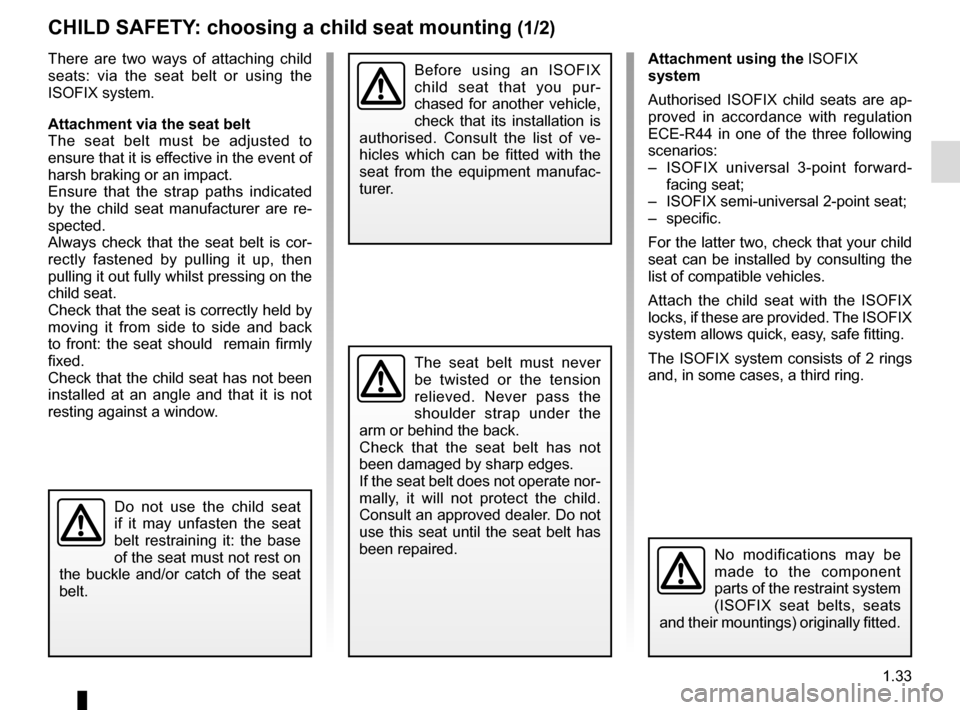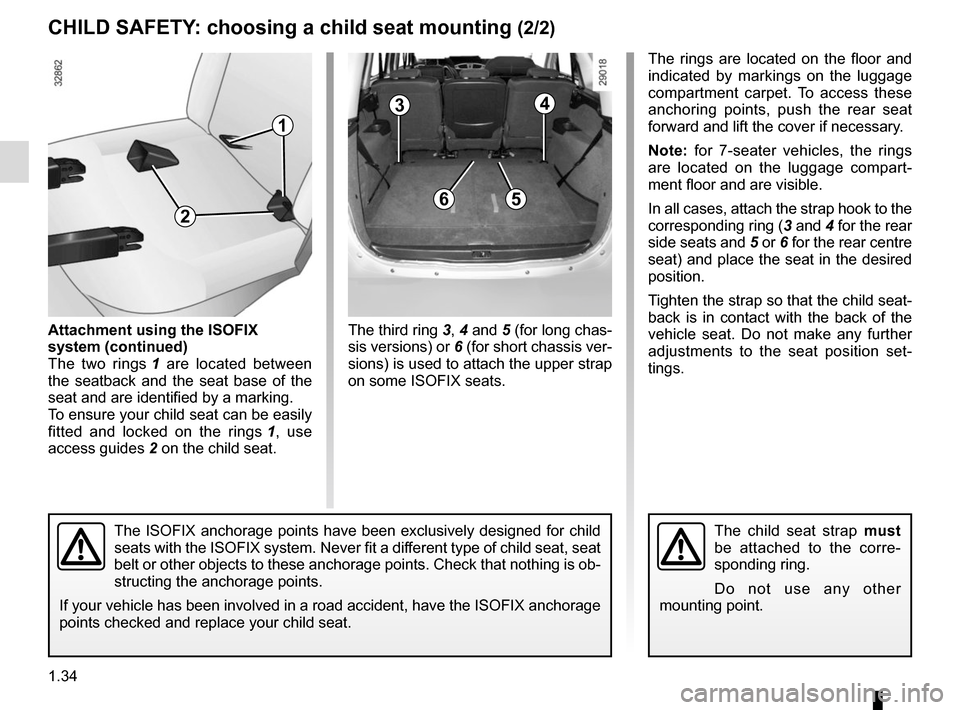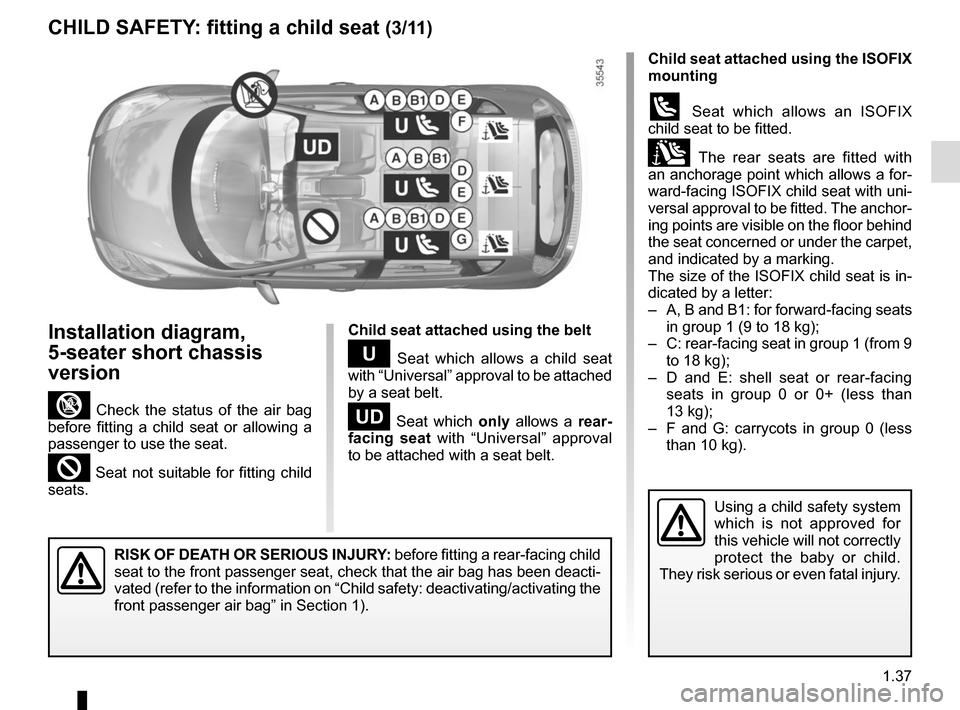2015 RENAULT SCENIC belt
[x] Cancel search: beltPage 39 of 270

1.33
CHILD SAFETY: choosing a child seat mounting (1/2)
There are two ways of attaching child
seats: via the seat belt or using the
ISOFIX system.
Attachment via the seat belt
The seat belt must be adjusted to
ensure that it is effective in the event of
harsh braking or an impact.
Ensure that the strap paths indicated
by the child seat manufacturer are re-
spected.
Always check that the seat belt is cor-
rectly fastened by pulling it up, then
pulling it out fully whilst pressing on the
child seat.
Check that the seat is correctly held by
moving it from side to side and back
to front: the seat should remain firmly
fixed.
Check that the child seat has not been
installed at an angle and that it is not
resting against a window.
No modifications may be
made to the component
parts of the restraint system
(ISOFIX seat belts, seats
and their mountings) originally fitted.
The seat belt must never
be twisted or the tension
relieved. Never pass the
shoulder strap under the
arm or behind the back.
Check that the seat belt has not
been damaged by sharp edges.
If the seat belt does not operate nor-
mally, it will not protect the child.
Consult an approved dealer. Do not
use this seat until the seat belt has
been repaired.
Do not use the child seat
if it may unfasten the seat
belt restraining it: the base
of the seat must not rest on
the buckle and/or catch of the seat
belt.
Attachment using the ISOFIX
system
Authorised ISOFIX child seats are ap-
proved in accordance with regulation
ECE-R44 in one of the three following
scenarios:
– ISOFIX universal 3-point forward- facing seat;
– ISOFIX semi-universal 2-point seat;
– specific.
For the latter two, check that your child
seat can be installed by consulting the
list of compatible vehicles.
Attach the child seat with the ISOFIX
locks, if these are provided. The ISOFIX
system allows quick, easy, safe fitting.
The ISOFIX system consists of 2 rings
and, in some cases, a third ring.Before using an ISOFIX
child seat that you pur-
chased for another vehicle,
check that its installation is
authorised. Consult the list of ve-
hicles which can be fitted with the
seat from the equipment manufac-
turer.
Page 40 of 270

1.34
CHILD SAFETY: choosing a child seat mounting (2/2)
34
The third ring 3, 4 and 5 (for long chas-
sis versions) or 6 (for short chassis ver-
sions) is used to attach the upper strap
on some ISOFIX seats.
The ISOFIX anchorage points have been exclusively designed for child
seats with the ISOFIX system. Never fit a different type of child seat, seat
belt or other objects to these anchorage points. Check that nothing is o\
b-
structing the anchorage points.
If your vehicle has been involved in a road accident, have the ISOFIX an\
chorage
points checked and replace your child seat.
Attachment using the ISOFIX
system (continued)
The two rings 1 are located between
the seatback and the seat base of the
seat and are identified by a marking.
To ensure your child seat can be easily
fitted and locked on the rings 1, use
access guides 2 on the child seat.
5
The rings are located on the floor and
indicated by markings on the luggage
compartment carpet. To access these
anchoring points, push the rear seat
forward and lift the cover if necessary.
Note: for 7-seater vehicles, the rings
are located on the luggage compart-
ment floor and are visible.
In all cases, attach the strap hook to the
corresponding ring ( 3 and 4 for the rear
side seats and 5 or 6 for the rear centre
seat) and place the seat in the desired
position.
Tighten the strap so that the child seat-
back is in contact with the back of the
vehicle seat. Do not make any further
adjustments to the seat position set-
tings.
6
The child seat strap must
be attached to the corre-
sponding ring.
Do not use any other
mounting point.
1
2
Page 41 of 270

1.35
CHILD SAFETY: fitting a child seat (1/11)
In the front seat
The laws concerning children travel-
ling in the front passenger seat differ in
every country. Consult the legislation in
force and follow the indications on the
diagram on the following page.
Before fitting a child seat in this seat (if
authorised):
– lower the seat belt as far as possible;
– move the seat as far back as possi-ble;
– gently tilt the seatback away from vertical (approximately 25°);
– on equipped vehicles, raise the seat base as far as possible.
Do not change these settings after the
child seat is installed.
Some seats are not suitable for fitting
child seats. The diagram on the follow-
ing page shows you how to attach a
child seat.
The types of child seats indicated may
not be available. Before using a differ-
ent child seat, check with the manufac-
turer that it can be fitted.
Fit the child seat in a rear
seat wherever possible.
Check that when installing
the child seat in the vehicle
it is not at risk of coming loose from
its base.
If you have to remove the headrest,
check that it is correctly stored so
that it does not come loose under
harsh braking or impact.
Always attach the child seat to the
vehicle even if it is not in use so that
it does not come loose under harsh
braking or impact.
RISK OF DEATH OR
SERIOUS INJURY: before
fitting a rear-facing child
seat to this seat, check
that the air bag has been deacti-
vated (refer to the information on
“Child safety: deactivating/activat-
ing the front passenger air bag” in
Section 1).
Page 42 of 270

1.36
CHILD SAFETY: fitting a child seat (2/11)
In the rear seat
A carrycot can be installed across the
vehicle and will take up at least two
seats. Position the child with his or her
feet nearest the door.
Move the front seat as far forward as
possible to install a rear-facing child
seat, then move back the seat in front
as far as it will go, although without al-
lowing it to come into contact with the
child seat.
For the safety of the child in the for-
ward-facing seat, do not move the seat
in front back past the middle of the
runner, do not tilt the seatback too far
(maximum of 25°) and move the seat
backwards as far as possible.
Check that the child seat is resting
against the back of the vehicle seat and
that the headrest of the vehicle is not
obstructing its use.
For 7-seater vehicles, the second row
rear seats must be pushed forward
before a child is seated in the third row
rear seats.In the rear centre seat
Some child seats are too wide to allow
access to the seat belt buckles. Check
that your child seat can be fitted in this
seat.
When fitting an ISOFIX child seat in
this place, ensure that the two seat
belt buckles are placed flat under the
child seat, except in the case of booster
seats attached to the ISOFIX locks,
whose fitting is authorised
Ensure that the child seat
or the child’s feet do not
prevent the front seat from
locking correctly. Refer to
the information on the “Front seat”
in Section 1 or “Rear seat operation”
in Section 3.
The floor of your vehicle
has storage spaces. Before
installing a child seat with
a floor support, ensure that
this seat can be correctly installed
by consulting the list of compatible
vehicles supplied with the child seat.
Risk of serious injury in the event of
sudden braking or accident.
When fitting a child seat
(Group 2 or 3 booster seat),
check that the seat belts op-
erate (wind) correctly: refer
to Section 1 “Rear seat belts”. If
necessary, adjust the position of the
vehicle seat.
Page 43 of 270

1.37
Child seat attached using the belt
¬ Seat which allows a child seat
with “Universal” approval to be attached
by a seat belt.
− Seat which only allows a rear-
facing seat with “Universal” approval
to be attached with a seat belt.
Installation diagram,
5-seater short chassis
version
³ Check the status of the air bag
before fitting a child seat or allowing a
passenger to use the seat.
² Seat not suitable for fitting child
seats.
CHILD SAFETY: fitting a child seat (3/11)
Child seat attached using the ISOFIX
mounting
ü Seat which allows an ISOFIX
child seat to be fitted.
± The rear seats are fitted with
an anchorage point which allows a for-
ward-facing ISOFIX child seat with uni-
versal approval to be fitted. The anchor-
ing points are visible on the floor behind
the seat concerned or under the carpet,
and indicated by a marking.
The size of the ISOFIX child seat is in-
dicated by a letter:
– A, B and B1: for forward-facing seats in group 1 (9 to 18 kg);
– C: rear-facing seat in group 1 (from 9 to 18 kg);
– D and E: shell seat or rear-facing seats in group 0 or 0+ (less than
13 kg);
– F and G: carrycots in group 0 (less than 10 kg).
Using a child safety system
which is not approved for
this vehicle will not correctly
protect the baby or child.
They risk serious or even fatal injury.
RISK OF DEATH OR SERIOUS INJURY: before fitting a rear-facing child
seat to the front passenger seat, check that the air bag has been deacti\
-
vated (refer to the information on “Child safety: deactivating/activ\
ating the
front passenger air bag” in Section 1).
Page 44 of 270

1.38
CHILD SAFETY: fitting a child seat (4/11)
Type of child seatWeight of
the child Seat size
ISOFIX Front passenger
seat (1) (5) Rear side seats Rear centre
seat
Carrycot fitted across the vehicle
Group 0 < 10 kg F, G X U - IL (2) U (2)
Shell seat/rear-facing seat
Group 0, 0+ and 1 < 13 kg and 9 to
18 kgE, D U U - IL (3) U - IL (3)
C U U (3) U (3)
Forward-facing seat
Group 1 9 to 18 kg A, B, B1 X U - IUF - IL (4) U - IUF - IL (4)
Booster seat
Group 2 and 3 15 to 25 kg and
22 to 36 kg
X U (4) U (4)
X = Seat not suitable for fitting child seats.
U = Seat which allows a child seat with “Universal” approval to be ins\
talled using a seat belt; check that it can be fitted.
IUF/IL = On equipped vehicles, seat which allows an approved “Universal/semi-u\
niversal” or “vehicle specific” child seat to be
attached using the ISOFIX system; check that it can be fitted.
(1) Only a rear-facing child seat can be fitted in this seat: raise the seat\
to the maximum and position it as far back as possible ,
tilting the seatback slightly (approximately 25°).
(2) A carrycot can be installed across the vehicle and will take up two seats\
. Position the child with his or her feet nearest the
door.
(3) Move the front seat as far forward as possible to install a rear-facing \
child seat, then move back the seat in front as far as it
will go, although without allowing it to come into contact with the chil\
d seat.
(4) Forward-facing child seat; position the seatback of the child seat in co\
ntact with the seatback of the vehicle seat. Adjust the
height of the headrest or remove it if necessary; do not push the seat i\
n front of the child more than halfway back on its run-
ners and do not recline the seatback more than 25°.
(5) RISK OF DEATH OR SERIOUS INJURY: before fitting a rear-facing child seat in the front passenger seat, ch\
eck
that the air bag deactivator is in the OFF position .
The table below summarises the information already shown on the diagram \
on the previous page, to ensure the regula-
tions in force are respected.
Page 45 of 270

1.39
CHILD SAFETY: fitting a child seat (5/11)
Child seat attached using the ISOFIX
mounting
ü Seat which allows an ISOFIX
child seat to be fitted.
± The rear seats are fitted with
an anchorage point which allows a for-
ward-facing ISOFIX child seat with uni-
versal approval to be fitted. The anchor-
ing points are visible on the floor behind
the seat concerned or under the carpet,
and indicated by a marking.
The size of the ISOFIX child seat is in-
dicated by a letter:
– A, B and B1: for forward-facing seats in group 1 (9 to 18 kg);
– C: rear-facing seat in group 1 (from 9 to 18 kg);
– D and E: shell seat or rear-facing seats in group 0 or 0+ (less than
13 kg);
– F and G: carrycots in group 0 (less than 10 kg).
Using a child safety system
which is not approved for
this vehicle will not correctly
protect the baby or child.
They risk serious or even fatal injury.
RISK OF DEATH OR SERIOUS INJURY: before fitting a rear-facing child
seat to the front passenger seat, check that the air bag has been deacti\
-
vated (refer to the information on “Child safety: deactivating/activ\
ating the
front passenger air bag” in Section 1).
Child seat attached using the belt
¬ Seat which allows a child seat
with “Universal” approval to be attached
by a seat belt.
− Seat which only allows a rear-
facing seat with “Universal” approval
to be attached with a seat belt.
Installation diagram,
5-seater long chassis
version
³ Check the status of the air bag
before fitting a child seat or allowing a
passenger to use the seat.
² Seat not suitable for fitting child
seats.
Page 46 of 270

1.40
CHILD SAFETY: fitting a child seat (6/11)
Type of child seatWeight of
the child Seat size
ISOFIX Front passenger
seat (1) (5) Rear side seats Rear centre
seat
Carrycot fitted across the
vehicle
Group 0 < 10 kg F, G X U - IL (2) U (2)
Shell seat/rear-facing seat
Group 0, 0+ and 1 < 13 kg and 9 to
18 kgE, D U U - IL (3) U - IL (3)
C U U - IL (3) U - IL (3)
Forward-facing seat
Group 1 9 to 18 kg A, B, B1 X U - IUF - IL (4) U- IUF - IL (4)
Booster seat
Group 2 and 3 15 to 25 kg and
22 to 36 kg
X U (4) U (4)
X = Seat not suitable for fitting child seats.
U = Seat which allows a child seat with “Universal” approval to be ins\
talled using a seat belt; check that it can be fitted.
IUF/IL = On equipped vehicles, seat which allows an approved “Universal/semi-u\
niversal” or “vehicle specific” child seat to be
attached using the ISOFIX system; check that it can be fitted.
(1) Only a rear-facing child seat can be fitted in this seat: raise the seat\
to the maximum and position it as far back as possible ,
tilting the seatback slightly (approximately 25°).
(2) A carrycot can be installed across the vehicle and will take up two seats\
. Position the child with his or her feet nearest the
door.
(3) Move the front seat as far forward as possible to install a rear-facing \
child seat, then move back the seat in front as far as it
will go, although without allowing it to come into contact with the chil\
d seat.
(4) Forward-facing child seat; position the seatback of the child seat in co\
ntact with the seatback of the vehicle seat. Adjust the
height of the headrest or remove it if necessary; do not push the seat i\
n front of the child more than halfway back on its run-
ners and do not recline the seatback more than 25°.
(5) RISK OF DEATH OR SERIOUS INJURY: before fitting a rear-facing child seat in the front passenger seat, ch\
eck
that the air bag deactivator is in the OFF position .
The table below summarises the information already shown on the diagram \
on the previous page, to ensure the regula-
tions in force are respected.